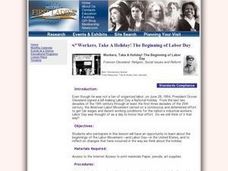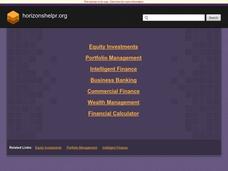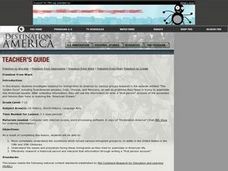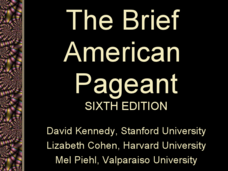National First Ladies' Library
Workers, Take a Holiday! the Beginning of Labor Day
When your upper elementary class returns in the fall, have them identify and define the beginnings of the labor movement and Labor Day in the United States. They thoughtfully reflect on changes that have occurred in the way we think...
Curated OER
Cotton And Child Labor
Eleventh graders investigate the practice of child labor as found in the history of the United States. The teacher reads the class a story from the year of 1914. This creates context for the lesson and then students answer teacher...
ProCon
Cuba Embargo
President John F. Kennedy bought 1,200 Cuban cigars the night before he enacted the Cuban trade embargo in 1962. Should the United States maintain the embargo? Using the website, pupils explore the topic to prepare for a class debate or...
Curated OER
The American Civil War (1861 -1864)
Peek back in time and learn about the North and South of the American Civil War. Discussed in full are the causes, effects, major battles, and agreements that made Civil War history. Period technology, social changes, and the ultimate...
Curated OER
Freedom Voices: Abolition and Suffrage in the United States
Learners explore abolition and suffrage in the United States.
Curated OER
Mexican American Labor in the U.S.
Ninth graders examine how the United States historically shifts policies toward Mexican and Mexican American laborers to acquire cheap, temporary labor. In this US History lesson, 9th graders research the history of immigration from...
Curated OER
Labor History in the United States
Eleventh graders read several articles regarding ethics and ethical behavior. They analyze the reasons for tragedies and circumstances surrounding the relationships between labor and owners. In small groups, 11th graders write a report...
Curated OER
Leaders, Laborers, and Other Perspectives of World War II
How did the women in France feel about their country’s involvement in World War II? Class groups are assigned a country involved in WWII, and individuals within the group adopt the point of view of leaders, laborers, businessmen, women,...
Weebly
Ancient China
From China's physical geography and earliest beginnings of civilization to the Qin and Han dynasties, here is a nicely designed worksheet on ancient China, which includes a graphic organizer and timeline to summarize the reading...
Curated OER
Oral History of World War II
Students research how citizens from the United States respond to the onset, duration and aftermath of World War II. They view clips from the movie "Swing Shift" and discuss the roles of civilians, minorities and military personnel. They...
Curated OER
Immigration to America
Students examine reasons for immigration to the United States in the 19th century. They role play as immigrants asked to write accounts of their immigrant experiences.
Curated OER
Border to Border
Learners use the Internet to gather information on the country of Mexico. They also discover the culture of their people and compare them with the United States population. They take a virtual tour of some of Mexico's most historical ruins.
Curated OER
Child Labor in America
Pupils interpret historical evidence presented in primary and secondary sources. In this child labor lesson, students examine the issue of child labor and determine how citizen action prompted the...
Syracuse University
American Industrial Revolution
While the Industrial Revolution may have fueled America's rise to the top of world markets, the child laborers often faced dangerous conditions. Using primary source images and other information, scholars consider what these children...
Core Knowledge Foundation
Isn’t It Exciting? (The American Industrial Revolution and Urbanization)
America was built on the ingenuity, work ethic, and foresight of our ancestors. Sixth graders learn about the complex Gilded Age in American history, including the prominent inventors and captains of industry, and how they all connect...
Curated OER
The Brief American Pageant: The Eisenhower Era
Starting with the election results of Eisenhower over Stevenson in 1952, this presentation features additional maps about the elections of 1956 and 1960, with electoral votes by state. Additional slides detail the Far East (Vietnam,...
Curated OER
The Brief American Pageant: The Resurgence of Conservatism
Take a short trip back in time with this presentation, which details the political and electoral contexts of 1980's and 1990's America. Covering the Gulf War as well as domestic economics, these slides feature easy-to-read charts and...
Curated OER
The Industrial Revolution
Students explore what life was like during the Industrial Revolution. In this United States History lesson, students analyze a specific job then complete a webquest about that job. Once their research is complete, students...
Curated OER
Big Business & Industrial Cities
This is a true gem. This PowerPoint is well-organized, has bullet points you control (which gives you time for discussion), has sound effects, and covers several aspects of American industrialization after 1900. The presentation begins...
Curated OER
Woodrow Wilson
In this online interactive history worksheet, students respond to 10 short answer and essay questions about the achievements of Woodrow Wilson. Students may check some of their answers on the interactive worksheet.
Curated OER
Three Centuries of Child Labor In America
Fifth graders investigate the history of child labor that is found in America. They use a variety of resources to conduct research. Students create cause and effect arguments using the information that is found. They also compare and...
Curated OER
Child Labor Laws in America and Nebraska
Students research child labor laws in Nebraska and America. In this child labor instructional activity, students examine primary and secondary sources regarding legislation on child labor and create posters that highlight the laws...
Curated OER
Teaching With Documents Lesson Plan: Photographs of Lewis Hine: Documentation of Child Labor
High schoolers interpret historical evidence presented in primary and secondary resources. In this child labor lesson, students examine photograhs by Lewis Hines and discuss the implications of child labor in America.























